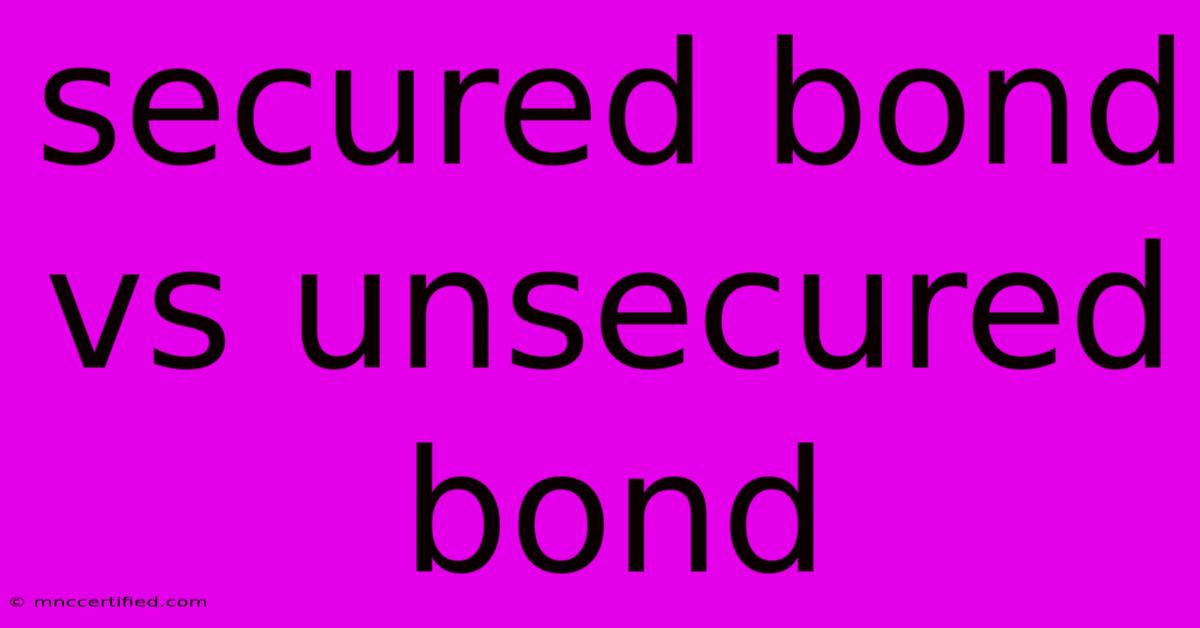Secured Bond Vs Unsecured Bond

Table of Contents
Secured Bond vs. Unsecured Bond: Understanding the Key Differences
Investing in bonds can be a crucial part of a diversified portfolio, offering a potentially stable income stream and lower risk compared to stocks. However, not all bonds are created equal. A key distinction lies between secured bonds and unsecured bonds, also known as debentures. Understanding the differences between these two types is crucial for making informed investment decisions. This article will delve into the specifics, helping you determine which type aligns best with your risk tolerance and financial goals.
What is a Secured Bond?
A secured bond, as the name suggests, is backed by collateral. This means that the issuer pledges specific assets as security for the bond. If the issuer defaults on its payment obligations, the bondholders have the right to seize and sell these assets to recover their investment. Common types of collateral include:
- Real estate: Mortgage-backed securities are a prime example, where the underlying asset is real estate.
- Equipment: Bonds issued by companies might be secured by their manufacturing equipment or other physical assets.
- Other assets: This could encompass a range of assets depending on the issuer and the specifics of the bond agreement.
This collateral provides a safety net for investors, reducing the risk of loss in case of default. Consequently, secured bonds typically offer lower interest rates than unsecured bonds because of their reduced risk profile. Think of it like this: the lower the risk, the lower the reward.
Key Features of Secured Bonds:
- Lower risk: The presence of collateral mitigates the risk of default.
- Lower interest rates: Due to the lower risk, these bonds generally pay lower interest rates.
- Priority in case of bankruptcy: Secured bondholders have priority over unsecured bondholders in claiming assets during bankruptcy proceedings.
What is an Unsecured Bond (Debenture)?
An unsecured bond, or debenture, is not backed by any specific collateral. The bond's value rests solely on the creditworthiness of the issuer. Investors rely on the issuer's ability to repay the principal and interest payments. This makes them inherently riskier than secured bonds.
Because of the higher risk involved, unsecured bonds typically offer higher interest rates to compensate investors for taking on that additional risk. This higher yield acts as an incentive to attract investors despite the increased potential for losses.
Key Features of Unsecured Bonds (Debentures):
- Higher risk: No collateral means higher risk of default.
- Higher interest rates: The higher risk is compensated with higher interest rates.
- Lower priority in bankruptcy: Unsecured bondholders are lower in the priority list for asset recovery during bankruptcy, meaning they may receive less or nothing at all.
Secured Bond vs. Unsecured Bond: A Comparison Table
| Feature | Secured Bond | Unsecured Bond (Debenture) |
|---|---|---|
| Collateral | Backed by specific assets | No collateral |
| Risk | Lower | Higher |
| Interest Rate | Lower | Higher |
| Priority in Bankruptcy | Higher | Lower |
| Example | Mortgage-backed securities | Corporate bonds, government bonds (some) |
Which is Right for You?
The choice between a secured and an unsecured bond depends entirely on your individual risk tolerance and investment goals.
- Risk-averse investors who prioritize capital preservation might prefer secured bonds, despite the lower returns.
- Investors seeking higher yields and willing to accept a greater risk might opt for unsecured bonds.
It's crucial to thoroughly research the issuer's financial health and credit rating before investing in either type of bond. Consulting a financial advisor can provide personalized guidance based on your specific circumstances. Diversifying your bond portfolio across different issuers and types can also help to mitigate risk.
SEO Optimization Considerations:
This article incorporates several on-page SEO strategies including:
- Targeted Keywords: "secured bond," "unsecured bond," "debenture," "bond investment," "risk tolerance," "credit rating," are strategically used throughout the text.
- Header Structure (H2, H3): Clear header structure improves readability and helps search engines understand the content's organization.
- Bold Text: Key terms are bolded for emphasis and improved scannability.
- Readability: The text is written in clear, concise language, avoiding jargon.
Off-page SEO strategies would involve building backlinks to this article from other relevant websites and online resources. This would boost the article's authority and ranking in search engine results pages (SERPs).

Thank you for visiting our website wich cover about Secured Bond Vs Unsecured Bond. We hope the information provided has been useful to you. Feel free to contact us if you have any questions or need further assistance. See you next time and dont miss to bookmark.
Featured Posts
-
No Money Down Bail Bonds Tulsa
Nov 26, 2024
-
Landlord Insurance Water Damage
Nov 26, 2024
-
British Soldier Captured In Ukraine By Russia
Nov 26, 2024
-
Red Sea Boat Sinks 16 Missing
Nov 26, 2024
-
Nile River Tours A New Era Of Cruises
Nov 26, 2024